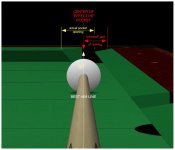By always striving for hitting center pocket, this helps establish a standard for what can be considered a "good" shot. If going for center pocket and miss to one side, this is an indicator something was wrong in the execution of the shot and needs attention to what it was so this error doesn't creep in as playing continues.
The source of these possible errors can from the players execution of the shot and the playing conditions.
Also, becoming proficient in hitting the center of the pocket, cheating the pocket becomes easier and is a very valuable skill to learn when you need to make a angle for a shot, need to squeeze a ball by a ball blocking a pocket and so on.
The ability to hit center pocket applies to banks as well. How the table is banking can be ascertained by how well the center of the pocket is being hit.
In addition, how the table felt is playing can be ascertained when not hitting center pocket on cut shots when that was the goal.
Basically, having a set point to hit or roll over on the table with an OB gives a known starting point to make needed adjustments or that you are hitting the OB well.
This level of precision may not seem necessary for cut shots, but when banking, combos, and caroms shots become part of your skill sets, this level of precision is necessary. The best place to start learning this precision is with the cut shot and hitting center pocket.
Pool really is a precision sport when played at the highest level. It is amazing how 1 mm can kill a run.
The source of these possible errors can from the players execution of the shot and the playing conditions.
Also, becoming proficient in hitting the center of the pocket, cheating the pocket becomes easier and is a very valuable skill to learn when you need to make a angle for a shot, need to squeeze a ball by a ball blocking a pocket and so on.
The ability to hit center pocket applies to banks as well. How the table is banking can be ascertained by how well the center of the pocket is being hit.
In addition, how the table felt is playing can be ascertained when not hitting center pocket on cut shots when that was the goal.
Basically, having a set point to hit or roll over on the table with an OB gives a known starting point to make needed adjustments or that you are hitting the OB well.
This level of precision may not seem necessary for cut shots, but when banking, combos, and caroms shots become part of your skill sets, this level of precision is necessary. The best place to start learning this precision is with the cut shot and hitting center pocket.
Pool really is a precision sport when played at the highest level. It is amazing how 1 mm can kill a run.
